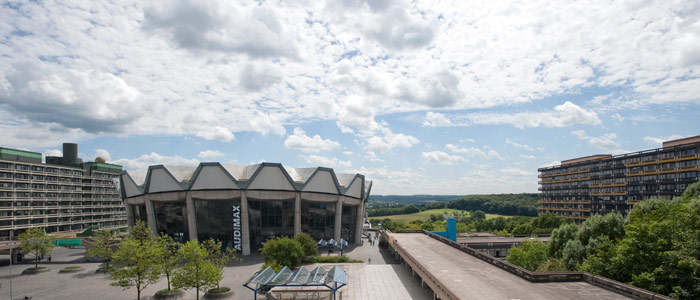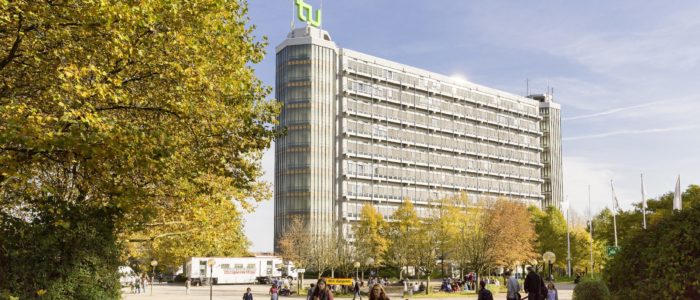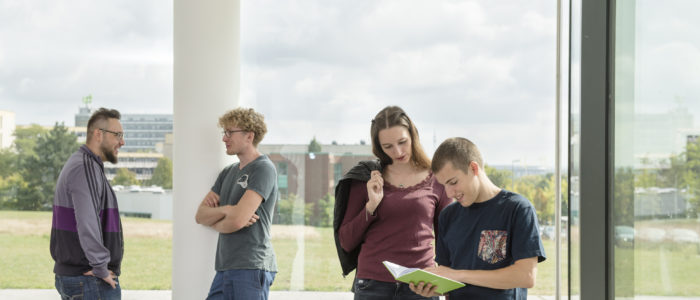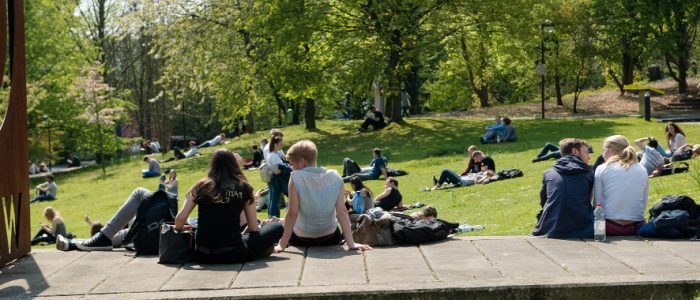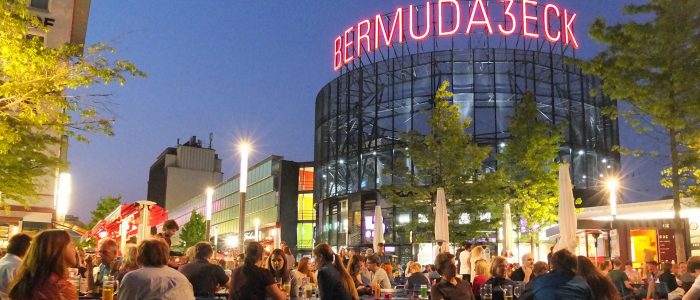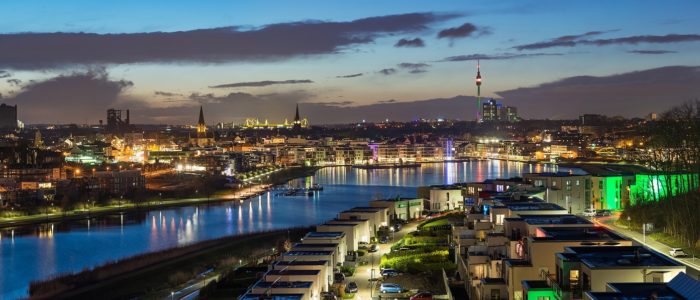The Universities
Bochum
The Ruhr-Universität Bochum (RUB) is one of Germany’s leading research universities. The RUB draws strengths from both the diversity and the proximity of the different scientific disciplines located at a single, coherent campus. This highly dynamic setting enables students and researchers to work across traditional boundaries of academic subjects and faculties. Host to over 40.000 students and about 4.700 staff, the RUB is a vital institution in the Ruhr area, which was selected as the European Capital of Culture for the year 2010. The RUB thus provides a vibrant environment for students, but also on- and off-campus cultural and leisure-time facilities.
Within Bochum, the RUB is divided into three locations: The main campus, the Mark 51°7, and the inner city of Bochum. It is furthermore part of the University Alliance of the Ruhr, providing strong links to the nearby universities of Essen and of course Dortmund.
Dortmund
Since its founding more than 50 years ago, TU Dortmund has developed a unique profile in teaching and research. With about 35.000 students and 16 faculties, ranging from science and engineering to social studies, cultural studies and humanities, TU Dortmund is one of the biggest universities in Germany and one of several institutions of higher learning in Dortmund. The combination of both classical and innovative degree programs and the university’s spirit of interdisciplinarity, communication, and cooperation make TU Dortmund a highly dynamic and fruitful place for both studying and research. TU Dortmund actively promotes international connections, involving a large number of university collaborations, partnerships, and exchange programmes around the world. Many cooperation partners for members of TU Dortmund are a lot closer to home, however, as the university is part of the University Alliance Ruhr (UAR), together with the neighbouring Ruhr University Bochum and the University of Duisburg-Essen.
Campus Life
Bochum
Built from 1962 to 1974, the Ruhr University was the first newly founded university in Germany after the second world war. Its layout closely follows the British example of a traditional campus university: Both educational and recreational facilities are located on a single patch of land, organized in different buildings for different areas of study. However, in line with the RUB’s ideal of closing the distance between different fields of research, all buildings are interconnected and diverge towards the central hub of the campus called the forum. Here, central facilities such as the university library, the public transport station and the dining hall (Mensa) are located.
Of course, you can also do various sports on campus, from archery, basketball and rowing all the way to tabletennis and yoga. Those are just a few of the over 100 different sports programs available, you can check out the entire list for yourself here.
However, all of this doesn’t mean that university activity is restricted to the campus only. As part of an effort to make research and teaching more accessible to everyone, the RUB also maintains multiple seminar and exhibition rooms within the city center such as the Blue Square and the Bochumer Fenster. Also, a new part of the campus is currently being built at the location of a former Opel factory, called Mark 51°7. There, scientific research from RUB institutions will support the growth of local startups while enabling students to apply their theoretical skills in practice.
Dortmund
TU Dortmund was founded amidst the post-war restructuring process in the region and is divided into two campuses, which are closely connected via the famous suspended railway system called “H-Bahn”. Almost a dozen cafeterias and coffee shops provided by the Studierendenwerk Dortmund, a state-of-the art central library and dozens of faculty libraries on both campuses, as well as its beautiful green spaces are typical hangout-spaces for the students.
Regional and local public transport seamlessly connect the university to downtown Dortmund and Bochum. Within a few minutes, you can find yourself in the centers of Dortmund or Bochum, exploring landmarks like the Dortmunder U or the Phoenixsee.
TU Dortmund promotes an active and integrative campus life with lots of student activities to choose from, varying from indoor and outdoor sports to theatre groups, film clubs and even gardening classes.
Collaborating with museums and cultural institutions like the Museum Ostwall, and scientific institutions such as the the Frauenhofer Institutes, or the DASA, TU Dortmund leaves its mark throughout the whole city, shaping its modern and energetic image.
The Cities
Bochum
The city of Bochum is part of the larger Ruhr area (ca. 5 million inhabitants), which ranks third in Europe in terms of density of cultural events and locations. Other cities in the Ruhr area, such as Essen, Duisburg, Dortmund and Oberhausen are reachable by train in under half an hour, and the main station of Bochum connects it to Germany’s high-speed ICE rail lines (connection to Düsseldorf in 40 minutes, to Cologne in 60 minutes, and to Berlin in 3.5 hours). Bochum also has good connections to destinations outside Germany via the conveniently reachable international airports in Düsseldorf, Cologne, and Dortmund.
The city itself is home to nearly 370.000 people, living in various districts, each of which has its own unique personality. Close to the university, student life dominates the picture of neighborhoods like Querenburg and Wiemelhausen, while the city center and the district of Langendreer are known for their shops, bars and illustrious nightlife. For those interested in industrial history, the Bergbaumuseum in Hamme or the railway museum in Dahlhausen are definitely worth a visit, while nature enthusiasts will enjoy relaxing at the Kemnader See just south of the campus or strolling through the lush forests of Bochum-Weitmar and -Linden.
Dortmund
Dortmund is located in the heart of the Ruhrgebiet, Germany’s largest urban centre. With more than 600.000 citizens, Dortmund is the third largest city of and a main economic and cultural hub in the state of North-Rhine Westphalia. As an ethnically and culturally diverse city, Dortmund has much to offer. Each of the various and multi-cultural districts of Dortmund has unique places and events to explore and embodies the easy-going way of life in the Ruhrgebiet.
Whether you want to immerse yourself in the experience of rooting for the BVB, visit museums and cultural institutions like the Museum Ostwall or the Depot, or just have a couple of beers in nightlife districts like the Nordstadt, Dortmund offers new and exciting things to discover.
Due to its central location, living and studying in Dortmund makes it easy and fun to explore other cities in the Ruhr area as well. The high-speed train and the Dortmund Airport connect you to other cities across Germany and Europe: within two or three hours, you can find yourself in places like Frankfurt, Hamburg, Brussels, or Amsterdam.
Further Information
More information about studying at the RUB can be found at the websites of the student office and the international office. There is also the OASE, which offers psychological counseling to any students of the RUB.
Images:
Slider 1: RUB, © Christian Nielingerr, TU, © Roland Baege
Slider 2: RUB. © Katja Marquard, TU, © Felix Schmale
Slider 3: Bochum Bermuda Dreieck, © Lutz Leitmann
